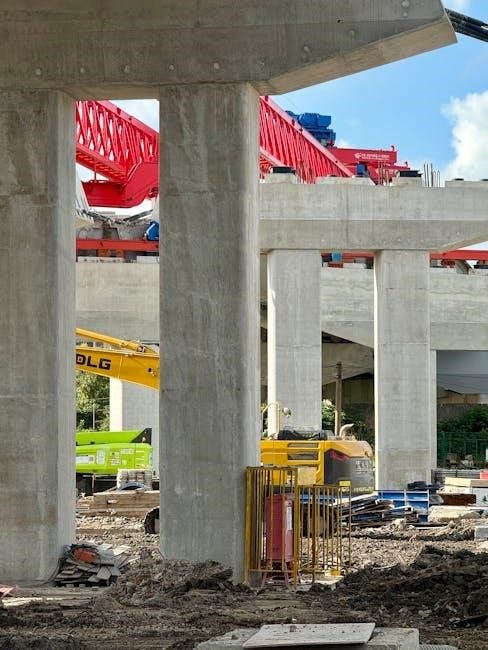
A Construction Estimate PDF is a detailed document outlining project scope, costs, and timelines. It ensures transparency and accountability, serving as a professional and secure reference for stakeholders.
1.1 Definition and Purpose
A Construction Estimate PDF is a pre-designed framework used to efficiently prepare professional and structured estimates for construction projects. It typically includes detailed breakdowns of costs, materials, labor, and timelines, ensuring clarity and transparency. The primary purpose of a construction estimate PDF is to provide a comprehensive overview of project expenses, helping contractors, clients, and stakeholders understand the scope and financial requirements. It serves as a essential tool for budgeting, planning, and decision-making, ensuring all parties are aligned. By offering a standardized format, it streamlines the estimation process, reduces errors, and enhances professionalism. This document is crucial for securing approvals, negotiating contracts, and maintaining project accountability, making it a cornerstone of successful construction management.
1.2 Importance in Construction Projects
A Construction Estimate PDF plays a vital role in construction projects by providing a clear and professional overview of costs, materials, and timelines. It ensures transparency and accountability, helping clients and stakeholders understand project requirements. This document is essential for securing approvals, negotiating contracts, and allocating resources effectively. By outlining detailed financial projections, it enables better decision-making and helps prevent cost overruns. The structured format of a Construction Estimate PDF also enhances collaboration, ensuring all parties are aligned on expectations. Its importance lies in its ability to mitigate risks, streamline communication, and provide a reliable reference point throughout the project lifecycle, ultimately contributing to successful project execution and client satisfaction.
Key Elements of a Construction Estimate
A construction estimate includes a project overview, scope of work, cost breakdown, material and labor costs, timeline, and terms and conditions to ensure clarity and accuracy.
2.1 Project Overview
The project overview section of a construction estimate provides a concise summary of the entire project, outlining its objectives, location, and key stakeholders involved. This section serves as an introduction, offering a clear understanding of the project’s scope and goals. It typically includes details such as the project name, client information, and a brief description of the work to be performed. The overview also highlights the expected outcomes and deliverables, ensuring all parties involved share a common understanding. Additionally, it may include a high-level timeline and budget range to set expectations. This section is crucial for aligning stakeholders and providing a foundation for the detailed estimates that follow.
2.2 Scope of Work
The scope of work is a detailed description of the tasks, deliverables, and responsibilities involved in the construction project. It clearly outlines what needs to be accomplished, including specific tasks, materials, and services required to complete the project. This section ensures that all stakeholders have a shared understanding of the work to be performed, preventing scope creep and miscommunication. The scope of work also defines the boundaries of the project, specifying what is included and what is excluded. By providing a clear roadmap of the work, it helps contractors and clients align expectations, ensuring the project is executed smoothly and efficiently. This section is essential for setting a solid foundation for the estimate.
2.3 Cost Breakdown

A cost breakdown is a detailed listing of all expenses associated with a construction project. It itemizes the costs of materials, labor, equipment, permits, and other related expenses. This section provides transparency by showing how the total estimate is derived, allowing clients to understand where their budget is allocated. The breakdown often includes subcategories such as site preparation, foundation work, framing, electrical systems, and finishes. Each line item is typically accompanied by unit prices, quantities, and total costs. This level of detail helps in tracking expenses, identifying potential cost-saving opportunities, and ensuring that the project stays within budget. Regular updates to the cost breakdown are essential as the project progresses.
2.4 Material and Labor Costs
Material and labor costs are the cornerstone of a construction estimate, representing the majority of the project’s expenses. Material costs include the price of all necessary supplies, such as lumber, concrete, steel, and finishes, while labor costs account for the wages of workers, including skilled tradespeople and laborers. These costs are typically calculated based on industry standards, supplier quotes, and local labor rates. Accurate estimation of these expenses ensures the project remains financially viable. Separating material and labor costs provides clarity, making it easier to identify cost-saving opportunities. For example, using alternative materials or optimizing labor schedules can significantly reduce expenses without compromising quality. Detailed breakdowns of these costs are essential for budgeting and project management.
2.5 Timeline and Phases
The timeline and phases section outlines the project’s schedule, breaking it into manageable stages. This helps in planning and executing tasks systematically. Each phase, such as site preparation, foundation work, or installation, is assigned a start and end date. A clear timeline ensures coordination among contractors, suppliers, and clients. It also helps monitor progress and address delays promptly. Including key milestones, like inspections or material deliveries, enhances transparency. The timeline is often linked to the budget, showing how costs are allocated across phases. This section is crucial for meeting deadlines and maintaining project efficiency. It ensures all stakeholders are aligned and aware of their responsibilities at each stage. Regular updates to the timeline are essential to reflect changes and keep the project on track;
2.6 Terms and Conditions
The terms and conditions section in a construction estimate PDF outlines the legal and contractual obligations between the client and the contractor. It includes payment terms, such as deposit requirements, installment schedules, and penalties for late payments. This section also specifies warranties or guarantees provided by the contractor for materials and labor. Clauses related to scope changes, known as change orders, are often included to address modifications to the original plan. Insurance and liability details are also covered, ensuring both parties understand their responsibilities in case of accidents or property damage. Finally, it may outline dispute resolution processes and the governing jurisdiction for legal matters. This section ensures transparency and protects both parties by clearly defining expectations and limitations. It is essential for maintaining a professional and legally binding agreement. Properly drafted terms and conditions help avoid misunderstandings and ensure smooth project execution.

Construction Estimate Formats
A construction estimate PDF is available in various formats, including PDF, Excel, and Word, each catering to different project needs and preferences for clarity and customization.
3.1 PDF Format
The PDF format is widely used for construction estimates due to its versatility and professional presentation. It ensures that the document remains consistent and readable across all devices. PDFs are often required for official bids, contracts, and project submissions, making them a standard in the industry. They are also secure, as they can be password-protected to prevent unauthorized edits or sharing. Contractors and clients prefer PDFs for their clarity and ability to embed images, such as schematics or blueprints. While PDFs are ideal for final versions, they can be challenging to edit without specialized software. Despite this, their universal compatibility and professional appearance make them a top choice for construction estimates.
3.2 Excel and Word Formats
Excel and Word formats are widely used in construction estimating for their flexibility and ease of use. Excel is particularly effective for creating detailed cost breakdowns, as it allows for complex calculations and dynamic updates. It is ideal for budgeting and quantifying materials and labor. Word documents, on the other hand, are better suited for textual descriptions, such as scope of work or terms and conditions. Both formats are easily editable, making them valuable during the drafting phase. However, they lack the professional presentation and security of PDFs, as they can be altered without trace. Despite this, Excel and Word remain essential tools for creating and refining construction estimates before finalizing them in PDF format.
3.4 Why PDF is Preferred
PDF is the preferred format for construction estimates due to its universal compatibility and professional presentation. It ensures that the estimate appears consistent and well-formatted across all devices, maintaining the intended layout and design. PDFs are also secure, as they cannot be easily altered, reducing the risk of unauthorized changes. Additionally, PDFs are easily shareable and accessible without requiring specific software, making them ideal for stakeholders. They also support digital signatures, enhancing their legal validity; Overall, PDFs strike a balance between professionalism, security, and convenience, making them the go-to format for finalizing and sharing construction estimates.

Creating a Construction Estimate
Creating a construction estimate involves gathering project details, defining scope, estimating costs, and documenting materials, labor, and timelines to provide a clear and accurate financial overview.
4.1 Steps to Create an Estimate
Creating a construction estimate involves several structured steps to ensure accuracy and comprehensiveness. First, review the project plans and specifications thoroughly. Next, break down the scope of work into measurable components. Estimate material quantities and costs, followed by labor costs based on industry rates. Consider equipment, overhead, and profit margins. Develop a detailed timeline and phases to align with the project schedule. Document all assumptions and potential risks. Finally, review and validate the estimate for accuracy before presenting it. Proper organization and clear documentation are essential to avoid errors and ensure client understanding. These steps help in delivering a precise and professional construction estimate PDF;
4.2 Tools for Estimate Creation
Various tools facilitate the creation of accurate construction estimates. Spreadsheets like Excel are widely used for detailed cost calculations, while Word processors help draft the estimate document. Specialized software, such as PlanGrid or Bluebeam, streamlines the process by integrating takeoff measurements and cost databases. These tools often support multiple formats, including PDF, ensuring professional and secure presentations. Additionally, cloud-based solutions enhance collaboration and accessibility; Proper utilization of these tools saves time, reduces errors, and ensures consistency in the final construction estimate PDF. They are essential for delivering precise and professional estimates tailored to project requirements.
4.3 Best Practices
Adhering to best practices ensures the creation of accurate and reliable construction estimates. Begin by clearly defining the scope of work to avoid ambiguities. Conduct detailed takeoffs to quantify materials and labor accurately. Use up-to-date cost databases and historical data to ensure pricing reflects current market rates. Maintain transparency by documenting assumptions and potential risks. Standardize your estimate format for consistency and readability. Regularly review and validate estimates with team members to minimize errors. Incorporate feedback from stakeholders to refine the estimate. Finally, leverage technology to streamline processes and improve accuracy. Following these practices enhances professionalism, reduces disputes, and builds trust with clients. Consistency and precision are key to successful construction estimates.
Free Construction Estimate Templates
Free construction estimate templates in Word, Excel, and PDF formats simplify the estimation process. They include sections for cost breakdown, scope of work, and timelines, ensuring comprehensive estimates.
5.1 Microsoft Word Templates
Microsoft Word templates for construction estimates offer a flexible and user-friendly solution. These templates are widely available online and can be downloaded for free from Microsoft’s template gallery or third-party sites. They provide pre-designed layouts with customizable fields for project details, scope of work, and cost breakdowns. Users can easily modify the content, formatting, and structure to suit their specific needs. Many Word templates include placeholder sections for company logos, client information, and signature blocks, making them professional and polished. They are especially useful for small to medium-sized projects where simplicity and quick customization are essential. These templates are compatible with other software, ensuring seamless integration into project management workflows.

5.2 Excel Templates
Excel templates are widely used for construction estimates due to their ability to handle complex calculations and detailed breakdowns. These templates are available for free or purchase from various sources, including Microsoft’s template gallery and third-party websites; They often include pre-built formulas and tables to automate calculations, such as labor costs, material prices, and total project expenses. Users can input data, and the template generates accurate estimates instantly. Excel templates are highly customizable, allowing contractors to add or remove sections based on project requirements. They are ideal for large-scale projects requiring precise financial planning. While they may require basic spreadsheet skills, Excel templates remain a powerful tool for creating professional and detailed construction estimates efficiently.
5.3 PDF Templates
PDF templates for construction estimates provide a professional and visually appealing format for presenting project details. These templates are widely available online and can be downloaded from platforms like Template.net or Etsy. They are designed to be user-friendly, with fillable fields for project names, dates, and cost details. PDF templates are ideal for creating polished final documents that can be easily shared with clients or stakeholders. Many templates are customizable, allowing users to add logos or brand colors. They are also compatible with most devices and ensure consistency in formatting. PDF templates are particularly useful for final submissions, as they are difficult to alter, ensuring the integrity of the estimate. This makes them a popular choice for professionals seeking a reliable and professional format.
5.4 Google Docs and Sheets
Google Docs and Sheets are versatile tools for creating and managing construction estimates. These cloud-based platforms allow real-time collaboration, making it easy for teams to work together remotely. Google Docs is ideal for drafting detailed project descriptions and scopes of work, while Google Sheets excels at calculating costs and creating detailed breakdowns. Both tools are accessible from any device with internet connectivity and offer automatic saving, reducing the risk of data loss. Additionally, Google’s sharing features enable seamless communication with clients and stakeholders. Templates for construction estimates are readily available online, and users can easily customize them to suit their needs. Google’s integration with other apps ensures smooth workflow, making it a convenient option for modern construction professionals.
5.5 Download Links and Resources
Accessing high-quality construction estimate templates is straightforward with various online resources. Websites like Template.net, Smartsheet, and Microsoft Office Online offer downloadable templates in PDF, Word, and Excel formats. Google Docs and Sheets templates are also available for free, providing customizable solutions. Additionally, construction-specific platforms like ProEst and ConstructionPlanner offer downloadable resources. Many websites provide templates with pre-designed formats, saving time and effort. Ensure to verify the reliability of sources and check for updates to comply with industry standards. Downloading templates from trusted sites ensures you get professional, editable, and virus-free files tailored to your construction estimating needs. Explore these resources to find the perfect template for your project.
Construction Estimating Software
Construction estimating software streamlines cost calculation, bid management, and project planning, ensuring accuracy and efficiency for contractors and project managers.
6.1 Top Software Tools
Several software tools are widely used in the construction industry for accurate estimating and project management. PlanGrid and Bluebeam are popular for their collaboration features and PDF markup capabilities, essential for creating detailed construction estimates. Procore offers comprehensive project management and estimating tools, while Autodesk provides advanced solutions for cost estimation and BIM integration. Trimble and Buildertrend are also recognized for their robust estimating and project tracking functionalities. These tools enhance accuracy, streamline workflows, and facilitate timely delivery of construction projects. They are preferred for their user-friendly interfaces, integration with other software, and ability to generate professional-grade construction estimate PDFs efficiently.
6.2 Free vs. Paid Tools
When it comes to construction estimating software, users often debate between free and paid tools. Free tools, such as basic Excel templates or open-source software, are ideal for small projects or businesses with limited budgets. However, they often lack advanced features like automated calculations, real-time collaboration, and detailed reporting. Paid tools, on the other hand, offer comprehensive functionalities, including cost databases, 3D modeling, and integration with other software. While they require an investment, they provide scalability and efficiency for large-scale projects. Free trials are often available for paid tools, allowing users to test their capabilities before committing. The choice depends on the project’s complexity and the organization’s needs.
6.3 Features to Consider

When selecting construction estimating software, it’s crucial to evaluate key features that align with your project needs. Cost databases and real-time pricing updates ensure accurate material and labor cost calculations. Integration capabilities with CAD, BIM, and accounting software enhance workflow efficiency. Automated calculations and error detection reduce manual errors, while customizable templates allow for tailored estimates. Collaboration tools enable teams to work together seamlessly. Additionally, reporting and analytics provide insights for decision-making. Mobile accessibility and cloud-based solutions are essential for on-site access. Finally, user-friendly interfaces and customer support are vital for smooth adoption and troubleshooting. These features collectively ensure the software meets both current and future project demands, delivering precise and professional construction estimates.

Best Practices for Estimates
Adopting best practices ensures accurate, transparent, and professional construction estimates. Standardize processes, maintain detailed records, and regularly review estimates for compliance and fairness.
7.1 Customization Tips

Customizing your construction estimate PDF is essential for clarity and professionalism. Always tailor the document to the specific project, including the company logo, client details, and project title. Use clear section headings and concise descriptions to avoid confusion. Highlight key sections like total costs and deadlines to draw attention. Ensure the format aligns with the client’s expectations, such as including a summary page or detailed breakdowns. Avoid overly technical language to make the document accessible to all stakeholders. Use color coding or bold text for important sections to enhance readability. Finally, proofread thoroughly to correct errors and ensure accuracy. These tips help create a polished, client-focused estimate that builds trust and professionalism.
7.2 Ensuring Accuracy

Ensuring accuracy in a construction estimate PDF is crucial for project success. Begin by double-checking all calculations and data entries to avoid errors. Use historical data and industry benchmarks to validate cost estimates. Break down the estimate into smaller components, such as materials and labor, to ensure each section is precise. Regularly update the estimate to reflect changes in material prices or project scope. Consult with experts or team members to verify assumptions and identify potential oversights. Use software tools to automate calculations and reduce human error. Finally, conduct a thorough review process, involving multiple stakeholders, to ensure the estimate is reliable and aligned with the project’s requirements. Accuracy builds credibility and helps prevent costly disputes.
7.3 Timely Delivery
Timely delivery of a construction estimate PDF is essential for maintaining project momentum and stakeholder confidence. Delays in providing estimates can lead to missed opportunities, extended decision-making processes, and potential cost escalations. To ensure timely delivery, set clear deadlines and prioritize tasks effectively. Utilize project management tools to track progress and assign responsibilities. Regular communication with team members and clients helps manage expectations and addresses potential bottlenecks early. Additionally, templating and automation tools can streamline the estimation process, reducing preparation time. Delivering estimates on time demonstrates professionalism and reliability, fostering trust with clients and partners. Consistent punctuality in estimate delivery contributes to long-term business success and stronger relationships in the construction industry.

7.4 Legal and Compliance
Ensuring legal and compliance standards is crucial when preparing a construction estimate PDF. This involves adhering to local building codes, environmental regulations, and labor laws. Contracts must outline clear terms, including payment schedules, liabilities, and dispute resolution processes. Compliance with industry standards ensures transparency and accountability, reducing the risk of legal disputes. It is essential to include disclaimers and ensure all documentation aligns with legal requirements. Regular updates to comply with changing regulations are necessary to avoid penalties. By maintaining legal integrity, construction estimates remain professional and trustworthy, fostering confidence among clients and stakeholders. Compliance also protects all parties involved from potential legal challenges, ensuring smooth project execution.
